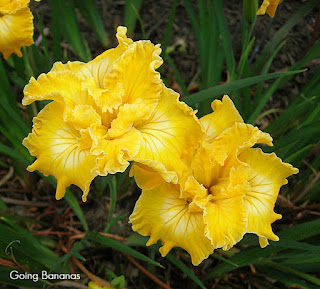'GOING BANANAS'
The Mitchell Medal is restricted to Pacific Coast Native (PCN) irises. It is named in honor of Sydney B. Mitchell (1878-1951). Professor Sydney Mitchell was an educator. He became Acting Librarian at the University of California during WW I, and later founded and became first director of the Graduate School of Librarianship at that university. He was also one of the organizers of the American Iris Society.
Tom Craig wrote this of him: "Sydney looked upon plant breeding as a long term international effort in which individuals from all over the world should co-operate and add generation after generation to a real human achievement. He made me feel a real part of this and more particularly a part of a special work started by William Mohr and carried on by himself. Sydney generously gave flowers and plants of seedling for further encouragement with this work."
Mitchell was also interested in the native irises of the West Coast, and promoted them at every opportunity. He took great pride in the plantings of PCNs in his own garden. He had a large collection of various forms of Iris innominata and I. douglasiana.
Previous award winners can be found at https://wiki.irises.org/Main/InfoAwards.
 |
| 'Going Bananas' photo by Mike Unser |
'Going Bananas' (Joseph Ghio, R. 2010) Seedling #JP-121Z. CA, 12" (30 cm). Early thru late bloom. Gold self, creamy white dime signal. Seedling #HP-152R2: (seedling #FP-273U2: (seedling #DP-260N2, 'Coin Of The Realm' pod parent, x seedling #DP-250, 'Marriage Proposal' sibling) x 'Bowl Of Fluff') X seedling #HP-125X2, 'Cashing In' sibling. Introduced by Bay View Gardens in 2010.
The World of Irises blog will be posting classification medal winners as soon as the hybridizers are notified. The entire list of winners, including Award of Merit and Honorable Mention, will be published on the AIS website, the AIS Encyclopedia, and later in the AIS Bulletin, IRISES.


























































